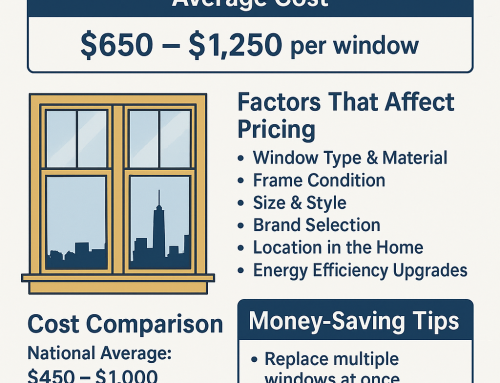
A precise measurement is the difference between a smooth installation and an expensive re-order. This homeowner-friendly guide shows you how to measure for insert and full-frame window replacements, with pro tips we use at Master Windows across New York.
Tools you’ll need
-
Tape measure (rigid)
-
Carpenter’s square & small level
-
Pencil + notepad (or phone)
-
Step ladder (if needed)
-
Helper (recommended)
-
Optional: straight edge, angle finder (for sill slope)
Pro Tip: Measure to the nearest 1/16 in. and write down the smallest number you find for width and height. You’ll usually subtract a small allowance so the new unit can be set plumb and square.
Decide your replacement type
-
Insert (pocket) replacement – New window fits inside the existing frame. Fastest and least invasive. You’ll measure frame-to-frame from indoors.
-
Full-frame replacement – Removes the entire old frame to expose the rough opening. Best when frames are rotted, out of square, or you want a bigger glass area. Measurements reference the rough opening (stud-to-stud).
If your frame shows rot, water damage, or major warping, plan on full-frame.
Part A: Measuring for Insert (Pocket) Replacement
1) Measure WIDTH (take 3)
Measure inside the existing frame, from jamb to jamb:
-
At the top, middle, and bottom.
-
Record the smallest width.
Installer allowance: Subtract 1/4 in. from the smallest width for an easy fit.
2) Measure HEIGHT (take 3)
Measure from the head jamb (top inside) down to the sill:
-
At the left, center, and right.
-
Record the smallest height, then subtract 1/4 in. for fit.
Watch the sill: Most sills are sloped. Measure to the highest point of the sill where the new window will sit (not the decorative stool).
3) Measure FRAME DEPTH
Measure the usable frame depth from the interior stop to the exterior stop (or from the interior trim edge to the point the exterior stop begins). Many insert units need ≥ 3-1/4 in. of depth. Note any interior blinds, security sensors, or storm windows that affect fit.
4) Check SQUARE
Measure both diagonals of the existing frame (inside corner to opposite inside corner).
-
If diagonals differ by > 1/4 in., the opening is out of square. Note it; your installer may shim or recommend full-frame.
Part B: Measuring for Full-Frame Replacement
Full-frame units are ordered to the rough opening (RO). Ideally, you measure after removing the interior trim to see the studs. If you’re pre-ordering, measure as best you can and confirm on demo day.
1) RO WIDTH (stud to stud)
Measure the narrowest distance between jack studs at top, middle, and bottom. Record the smallest.
2) RO HEIGHT (sill to header)
Measure from the sub-sill (or rough sill) up to the header at left, center, right. Record the smallest.
3) RO DEPTH / WALL THICKNESS
Note wall thickness and exterior type (brick, vinyl, wood, stucco). If ordering nail-fin windows, factor in exterior details (flashing, returns, brickmould).
4) Square & Plumb
Check diagonals, and use a level on the sides and sill. Large variances may require framing repair or a slightly different sizing strategy.
Code tip (bedrooms): If replacing in a sleeping room, confirm egress size requirements for your municipality.
Extra measurements & site conditions
-
Mullions / Grids: Note any dividers that affect sizing.
-
Obstructions: Security sensors, blinds/shutters, AC units, window guards (common in NYC).
-
Exterior access: Fire escapes, brick veneer, and brownstone trims may affect install method.
-
Quantity & labeling: Label each opening by room and orientation (e.g., “2nd Fl Front Left”).
When to call a pro
-
The frame is rotted, out of square > 1/4 in., or won’t hold fasteners.
-
You’re unsure about the sill slope, depth, or egress.
-
Historic façades or brownstone details need special solutions.
Master Windows can measure for you—for free. We service NYC, Queens, Brooklyn, and Long Island.
Get a free professional measurement & quote
Call 516-888-0122 or email Sales@MasterWindows.com.





